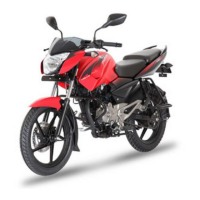Non-Use Maintenance
Non-use maintenance is necessary if a vehicle
remains off road for a longer duration (more
than 15 days**). The correct and careful non-
use maintenance carried out before storing
the vehicle will prevent the vehicle from
rusting and from such other non-operational
damages like fire hazards.
• Clean the entire vehicle thoroughly.
• Empty the fuel from the fuel tank and
carburettor float bowl (if fuel is left in for a
longer time, the fuel will break and gummy
substance could clog the carburettor).
• Remove spark plug & put several drops of
2T oil into the cylinder. Kick engine over
slowly a few times to coat cylinder wall
with oil & install back spark plug.
• Set the vehicle on a box or a stand so that
both wheels are raised off the ground.
• Spray oil on all unpainted metal surfaces to
prevent rusting. Avoid getting oil on rubber
parts or brake liners.
• Cover entire vehicle neatly. Make sure that
storage area is well ventilated & free from
any source of flames or spark.
• Fill 10% excess air pressure in both
wheels.
• Do not apply oil on front brake disc, to
prevent rusting. If the front brake disc rusts
during storage, do not attempt to clean it
with soap water. The rust will go off
automatically during first few application of
brake.
** For Battery :
a. Remove battery and keep it on wooden
plank, in properly ventilated area.
b. Before taking the vehicle for use.
• Get the battery recharged from the
Authorised Service Center / Battery Dealer.
• Apply p etroleum j el ly on termi na ls .
(applicable to certain models).
Preparation for regular use after storage :
• Clean the vehicle
• Make sure the spark plug is tight.
• Fill the fuel tank with fuel.
• Change the engine oil.
• Check all the points listed in the Daily
Safety Checks section.
• Check and inflate tyres to proper tyre
pressure.

